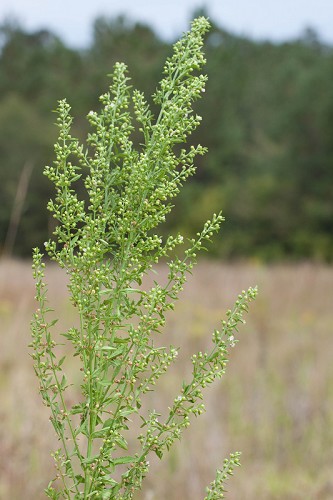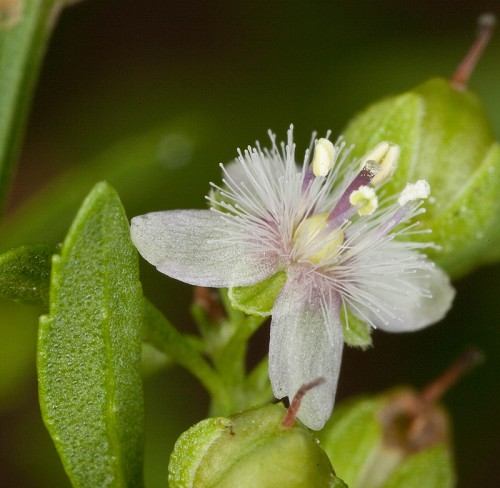Difference between revisions of "Scoparia dulcis"
Krobertson (talk | contribs) |
|||
| Line 22: | Line 22: | ||
==Description== | ==Description== | ||
<!-- Basic life history facts such as annual/perrenial, monoecious/dioecious, root morphology, seed type, etc. --> | <!-- Basic life history facts such as annual/perrenial, monoecious/dioecious, root morphology, seed type, etc. --> | ||
| − | It is a ruderal species | + | It is a ruderal species. <ref name="FSU Herbarium">Florida State University Robert K. Godfrey Herbarium database. URL: [http://herbarium.bio.fsu.edu http://herbarium.bio.fsu.edu]. Last accessed: November 2015. Collectors: Loran C. Anderson, Lisa Keppner, R. Komarek, Annie Schmidt, Cecil R. Slaughter. States and Counties: Florida: Liberty, Jefferson, St. Johns, Taylor, Washington. Compiled by Tall Timbers Research Station and Land Conservancy.</ref> |
| − | "Erect, profusely branched perennial, 3-8 dm tall, the stems pubescent. Especially about the nodes. Leaves glandular-punctate, opposite, ovate-lanceolate to rhombic-ovate, 1-3 cm long, 6-16 mm wide, the distal ½-2/3 serrate. Flowers axillary, usually solitary, pedicel shorter than the petiole of the subtending leaf; calyx 4-parted, 1.5-2 mm long, the lobes widely ovate to elliptic, equaling or much exceeding the tube; corolla 4-parted, white, rotate, regular, the throat lanose, lobes ca. 1 mm long; stamens 4. Capsule subglobose to widely ellipsoid, ca. 2 mm long or broad." | + | "Erect, profusely branched perennial, 3-8 dm tall, the stems pubescent. Especially about the nodes. Leaves glandular-punctate, opposite, ovate-lanceolate to rhombic-ovate, 1-3 cm long, 6-16 mm wide, the distal ½-2/3 serrate. Flowers axillary, usually solitary, pedicel shorter than the petiole of the subtending leaf; calyx 4-parted, 1.5-2 mm long, the lobes widely ovate to elliptic, equaling or much exceeding the tube; corolla 4-parted, white, rotate, regular, the throat lanose, lobes ca. 1 mm long; stamens 4. Capsule subglobose to widely ellipsoid, ca. 2 mm long or broad." <ref name="Radford et al 1964">Radford, Albert E., Harry E. Ahles, and C. Ritchie Bell. Manual of the Vascular Flora of the Carolinas. 1964, 1968. The University of North Carolina Press. 937. Print.</ref> |
==Distribution== | ==Distribution== | ||
==Ecology== | ==Ecology== | ||
===Habitat=== <!--Natural communities, human disturbed habitats, topography, hydrology, soils, light, fire regime requirements for removal of competition, etc.--> | ===Habitat=== <!--Natural communities, human disturbed habitats, topography, hydrology, soils, light, fire regime requirements for removal of competition, etc.--> | ||
| − | In the Coastal Plain in Florida, ''S. dulcis'' can occur in moist loam around ponds and bordering adjacent woodlands. It has been observed in disturbed sites such as waste areas, powerlines corridors, fallow fields, and the upper edge of a restored marshy area | + | In the Coastal Plain in Florida, ''S. dulcis'' can occur in moist loam around ponds and bordering adjacent woodlands. It has been observed in disturbed sites such as waste areas, powerlines corridors, fallow fields, and the upper edge of a restored marshy area. <ref name="FSU Herbarium"/> |
===Phenology=== <!--Timing off flowering, fruiting, seed dispersal, and environmental triggers. Cite PanFlora website if appropriate: http://www.gilnelson.com/PanFlora/ --> | ===Phenology=== <!--Timing off flowering, fruiting, seed dispersal, and environmental triggers. Cite PanFlora website if appropriate: http://www.gilnelson.com/PanFlora/ --> | ||
| − | Flowers in September and fruits in August and September | + | Flowers in September and fruits in August and September. <ref name="FSU Herbarium"/> |
<!--===Seed dispersal===--> | <!--===Seed dispersal===--> | ||
<!--===Seed bank and germination===--> | <!--===Seed bank and germination===--> | ||
<!--===Fire ecology===--> <!--Fire tolerance, fire dependence, adaptive fire responses--> | <!--===Fire ecology===--> <!--Fire tolerance, fire dependence, adaptive fire responses--> | ||
===Pollination=== | ===Pollination=== | ||
| − | The following Hymenoptera families and species were observed visiting flowers of ''Scoparia dulcis'' at Archbold Biological Station | + | The following Hymenoptera families and species were observed visiting flowers of ''Scoparia dulcis'' at Archbold Biological Station: <ref name="Deyrup 2015">Deyrup, M.A. and N.D. 2015. Database of observations of Hymenoptera visitations to flowers of plants on Archbold Biological Station, Florida, USA.</ref> |
Megachilidae: ''Megachile albitarsis'' | Megachilidae: ''Megachile albitarsis'' | ||
| Line 50: | Line 50: | ||
==References and notes== | ==References and notes== | ||
| − | |||
| − | |||
| − | |||
| − | |||
| − | |||
Revision as of 14:42, 8 August 2016
| Scoparia dulcis | |
|---|---|

| |
| Photo by John R. Gwaltney, Southeastern Flora.com | |
| Scientific classification | |
| Kingdom: | Plantae |
| Division: | Magnoliophyta - Flowering plants |
| Class: | Magnoliopsida – Dicotyledons |
| Order: | Scrophulariales |
| Family: | Scrophulariaceae |
| Genus: | Scoparia |
| Species: | S. dulcis |
| Binomial name | |
| Scoparia dulcis L. | |

| |
| Natural range of Scoparia dulcis from USDA NRCS Plants Database. | |
Common names: Licorice weed, Sweet-broom
Contents
Taxonomic notes
Description
It is a ruderal species. [1]
"Erect, profusely branched perennial, 3-8 dm tall, the stems pubescent. Especially about the nodes. Leaves glandular-punctate, opposite, ovate-lanceolate to rhombic-ovate, 1-3 cm long, 6-16 mm wide, the distal ½-2/3 serrate. Flowers axillary, usually solitary, pedicel shorter than the petiole of the subtending leaf; calyx 4-parted, 1.5-2 mm long, the lobes widely ovate to elliptic, equaling or much exceeding the tube; corolla 4-parted, white, rotate, regular, the throat lanose, lobes ca. 1 mm long; stamens 4. Capsule subglobose to widely ellipsoid, ca. 2 mm long or broad." [2]
Distribution
Ecology
Habitat
In the Coastal Plain in Florida, S. dulcis can occur in moist loam around ponds and bordering adjacent woodlands. It has been observed in disturbed sites such as waste areas, powerlines corridors, fallow fields, and the upper edge of a restored marshy area. [1]
Phenology
Flowers in September and fruits in August and September. [1]
Pollination
The following Hymenoptera families and species were observed visiting flowers of Scoparia dulcis at Archbold Biological Station: [3]
Megachilidae: Megachile albitarsis
Conservation and management
Cultivation and restoration
Photo Gallery
Flower of Scoparia dulcis Photo by John R. Gwaltney, Southeastern Flora.com
References and notes
- ↑ 1.0 1.1 1.2 Florida State University Robert K. Godfrey Herbarium database. URL: http://herbarium.bio.fsu.edu. Last accessed: November 2015. Collectors: Loran C. Anderson, Lisa Keppner, R. Komarek, Annie Schmidt, Cecil R. Slaughter. States and Counties: Florida: Liberty, Jefferson, St. Johns, Taylor, Washington. Compiled by Tall Timbers Research Station and Land Conservancy.
- ↑ Radford, Albert E., Harry E. Ahles, and C. Ritchie Bell. Manual of the Vascular Flora of the Carolinas. 1964, 1968. The University of North Carolina Press. 937. Print.
- ↑ Deyrup, M.A. and N.D. 2015. Database of observations of Hymenoptera visitations to flowers of plants on Archbold Biological Station, Florida, USA.
